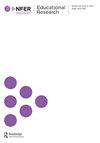Places and spaces: exploring interconnections between school environment, resources and social relations
IF 2.6
3区 教育学
Q1 EDUCATION & EDUCATIONAL RESEARCH
引用次数: 0
Abstract
ABSTRACT Background Relational issues at school, including bullying, tend to be interpreted primarily in terms of the behaviour of individual students. Whilst research has broadened this focus, more needs to be understood about how the design and management of the school environment and its resources may influence peer relations. Purpose The study sought to consider interconnections between the physical and organisational environment, resources, and social relations in school settings. Method Ethnographic research was conducted at three schools in Sweden, consisting of 6 to 8 weeks of participant observations at each school, and interviews with school safety or health teams, 21 teachers, and 121 students from preschool class (ages 6–7) to sixth grade (ages 12–13). Field notes and interview data were analysed using an approach based on constructivist grounded theory. Findings In-depth analysis of data identified a complex network of interconnections between the school environment, resources and peer relationships. In particular, it illuminated how competition for limited resources can influence social relations negatively. This may lead to brief minor conflicts, which, in turn, could potentially precipitate or become part of more systematic school bullying situations. Conclusions Our findings highlight the significance of decisions about the uses of space in schools, including choices in design (e.g. of play spaces) and the distribution of resources (e.g. equipment). Deeper understanding of the interconnections between the school environment, resources and peer relations can help inform efforts to support student wellbeing.场所与空间:探索学校环境、资源与社会关系之间的相互联系
本文章由计算机程序翻译,如有差异,请以英文原文为准。
求助全文
约1分钟内获得全文
求助全文
来源期刊

Educational Research
EDUCATION & EDUCATIONAL RESEARCH-
CiteScore
4.00
自引率
2.90%
发文量
0
期刊介绍:
Educational Research, the journal of the National Foundation for Educational Research (NFER), was established in 1958. Drawing upon research projects in universities and research centres worldwide, it is the leading international forum for informed thinking on issues of contemporary concern in education. The journal is of interest to academics, researchers and those people concerned with mediating research findings to policy makers and practitioners. Educational Research has a broad scope and contains research studies, reviews of research, discussion pieces, short reports and book reviews in all areas of the education field.
 求助内容:
求助内容: 应助结果提醒方式:
应助结果提醒方式:


